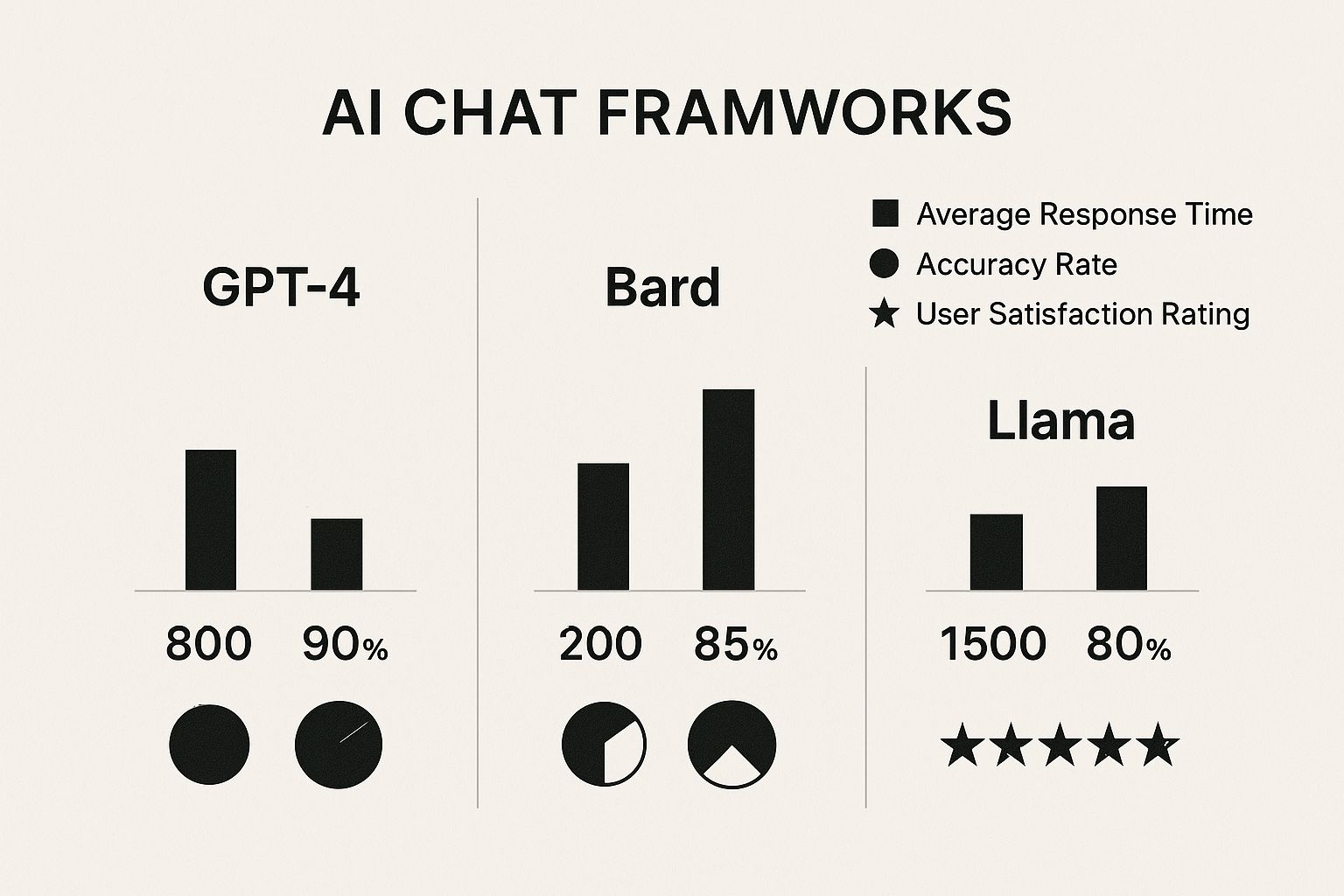Create Your Own AI Girlfriend 😈
Chat with AI Luvr's today or make your own! Receive images, audio messages, and much more! 🔥
4.5 stars

Ever wish you could just step inside your favorite fantasy world and have a real conversation with the characters? That's the magic of fantasy AI chat. It bridges the gap between passively reading a story and actively living inside one, turning entertainment into a personal, conversational adventure.
This isn't just about simple Q&A bots; it's a specific kind of artificial intelligence built from the ground up for immersive roleplaying and interactive storytelling in fantasy realms.
What Is Fantasy AI Chat and Why Is It So Popular?

Think of it less like a website's customer service bot and more like a dedicated, always-on Dungeon Master or a method actor who never, ever breaks character. These platforms are where you can build stories together, explore incredibly detailed worlds, and chat with complex characters, all through the power of conversation.
And this isn't some tiny niche hobby. It's part of a huge wave in technology. The whole AI chatbot market is booming, with a recent valuation somewhere between $10 billion and $15 billion. Experts predict it could swell to almost $47 billion in the next five years as more and more industries jump on board. You can dive deeper into this explosive growth by checking out recent AI chatbot statistical analyses.
The Ingredients Behind the Digital Magic
So, how does a piece of software convincingly portray a cunning elven rogue or a wise, ancient dragon? It’s not one single thing, but a few key technologies working together. Once you understand the components, the "magic" becomes a lot clearer and even more impressive.
To really get what makes these fantasy AI chat platforms tick, it helps to break down the core technology. Here's a look at the essential parts and why each one is so important for creating a believable experience.
Core Components of Fantasy AI Chat Explained
| Component | What It Is | Why It Matters for Fantasy Chat |
|---|---|---|
| Large Language Models (LLMs) | The "brain" of the AI. These are massive neural networks trained on vast libraries of text—books, articles, and huge chunks of the internet. | This is what gives the AI its ability to understand context, generate dialogue that sounds human, and spin a coherent narrative on the fly. |
| Character Personas | Think of this as the AI's "character sheet" or script. It's a set of instructions defining a character's backstory, personality, motivations, and even their unique way of speaking. | This is what keeps the AI in character. It’s the difference between a generic bot and a convincing, gruff dwarf or a charming, witty sorceress. |
| Memory Systems | A system that allows the AI to remember what you've talked about before. It tracks key details from your conversation over time. | Immersion depends on this. It lets the AI recall your name, your past decisions, and important plot points, making the story feel continuous and personal. |
These pieces combine to create an experience that feels alive and responsive, pulling you deeper into the world.
Why Is Everyone Talking About Fantasy AI Chat?
The draw of fantasy AI chat goes way beyond just a fun distraction. It connects with some core human desires: to create, to explore, and to feel a sense of connection.
For writers and world-builders, it's an incredible brainstorming tool. Imagine "interviewing" one of your own characters to see how they'd react in a certain situation, helping you flesh out their personality in ways you hadn't considered.
For roleplayers, it offers a kind of freedom that’s hard to find anywhere else. You’re not stuck on a pre-written path like in most video games. Here, your imagination is the only real limit. Want to lead a diplomatic envoy to a dragon's lair? Go for it. Investigate a mysterious curse plaguing a forgotten city? You can. Or maybe you just want to share a quiet moment with a companion in a tavern. The story is truly yours.
At its heart, fantasy AI chat is a collaborative storytelling engine. It empowers users to move from being passive consumers of fantasy content to active participants and co-authors of their own unique adventures.
This shift toward interactive entertainment is fundamentally changing how we engage with our passions. Instead of just reading about a world, you can now step inside and leave your own mark. That power—to create, interact, and explore on your own terms—is exactly why this technology is becoming so incredibly popular.
How AI Makes Your Fantasy Worlds Feel Real
So, how does an AI actually pull off creating these incredible fantasy worlds? It helps to peek behind the curtain. Don't worry, we're skipping the dense technical stuff. Instead, think of the AI as a world-class method actor, one who has spent months living and breathing their character. They've memorized the entire script, studied the character's deepest motivations, and know the history of their world inside and out.
This "actor" isn't just winging it. Developers train the AI on a massive diet of information. This isn't just a few books; it's everything from detailed character profiles and world-building bibles to entire libraries of fantasy novels and historical texts. The AI digests all of this to build a deep understanding of how a specific character would talk, think, and react in any situation.
At the heart of it all is what's called a Large Language Model (LLM). This is the creative engine that generates all the dialogue and story developments. Every message you send is like a director giving a cue, guiding the actor's performance and steering the narrative.
The Power of AI Memory
What truly sells the experience and makes it feel real is AI memory. This is far more than just a simple chat log. It's a dynamic system that actively remembers important details from your conversation, weaving them together to build a consistent story that's completely unique to you.
Let's say you tell an AI companion that your character is terrified of spiders. A good AI won't forget that. Weeks later, as you're creeping through a dark forest, the AI might have your companion whisper, "Stay close. I know you're not a fan of things with eight legs."
That ability to remember and bring up past details is what turns a basic chatbot into a genuine storytelling partner. It transforms a string of messages into a single, continuous narrative where your choices and history actually matter.
This is the secret sauce that separates a forgettable bot from a character you truly connect with. You can dive into all the different features that make these journeys more personal, as platforms are always working to make these interactions more seamless and believable.
The Engine Behind the Experience
All of this is powered by the incredibly fast-moving world of generative AI. While giants like ChatGPT and Gemini get a lot of headlines, smaller, more specialized platforms are quickly gaining loyal followings. For instance, a recent report on generative AI chatbot market shares pointed out that the AI chatbot Perplexity shot up from 2.7% to 6.5% market share in about a year.
That kind of growth tells us one thing: the technology is getting better, fast. For anyone using fantasy AI chat, this is great news. It means the AI's ability to stay in character, remember your story, and create compelling plots is constantly improving. The "actor" you're interacting with is always learning and getting more skilled, which leads to richer and more unforgettable adventures. Knowing how it works helps you become a better director for your own story.
Creative Ways to Use Fantasy AI Chat

That screenshot right there, from a well-known AI chat platform, perfectly captures what makes this technology so special. It’s a menu of characters, a gateway that lets you jump straight into a conversation and turn a wild idea into a real, back-and-forth interaction. It’s where fantasy meets reality.
Once you get the hang of the basics, the real fun can start. Think of a fantasy AI chat as your personal creative playground, with the only limits being your own imagination. It's more than just a piece of software; it’s a collaborator ready to help you build, explore, and play in ways that were pure science fiction just a few years ago.
So, let's dive into some of the coolest ways people are using these tools to become storytellers, world-builders, and adventurers.
Become the Hero of Your Own Solo Adventure
Ever had an itch to play a Dungeons & Dragons-style game but couldn't get the group's schedules to align? It’s a classic problem. A fantasy AI chat can step in as your personal, always-on-call Game Master (GM). You can launch into epic solo quests where the AI paints a picture of the world, voices all the non-player characters (NPCs), and adapts to every single choice you make.
Picture this: you're a rogue trying to sneak into a heavily guarded castle. You tell the AI what you're doing, and it brings the scene to life.
You: "I silently scale the western wall under the cover of darkness, my grappling hook catching the edge of the parapet."
AI GM: "The stone is cold and slick with dew beneath your fingers. As you reach the top, a lone guard on patrol turns the corner, his lantern swinging lazily. He hasn't spotted you yet. What do you do?"
That kind of dynamic exchange creates a living, breathing adventure built just for you. You call the shots, you set the pace, and you are the star of your own saga.
Bring Your Fictional Characters to Life
If you're a writer, you know the struggle of making a character feel real. You want them to have a distinct voice and personality, not just be a collection of traits on a page. A fantasy AI chat offers a fantastic way to do this: you can literally talk to your own characters. Feed the AI your character's backstory, personality quirks, and goals, and it will generate a digital version for you to interact with.
This isn’t just an outline; it's a rehearsal. Suddenly, you can:
- Test Dialogue: See how your stoic warrior or witty mage actually sounds when responding to different questions.
- Explore Backstory: Ask them about their childhood or their biggest regret and uncover details you never even considered.
- Pressure-Test Motivations: Throw a moral dilemma at them and see how they react, which helps solidify their core conflicts.
This is a hands-on method for writers to pull their characters off the page and into a dynamic, conversational space, making them feel authentic before a single chapter is written.
Explore Your World Through Interactive Worldbuilding
For any fantasy creator, building a believable world is a huge undertaking. Instead of just writing pages and pages of lore, you can use a fantasy AI chat to explore your creation firsthand. Create a persona for an "average" citizen—a blacksmith in a mountain city, a scholar in a grand library—and just start asking questions.
This transforms worldbuilding from a static writing exercise into an immersive experience. Interview a city guard about local crime, chat with a merchant about trade routes, or ask an elder to recount forgotten legends. The AI's answers, grounded in the lore you provide, can spark incredible new ideas and add layers of depth to your setting.
This kind of tech is quickly becoming a go-to for modern creators. While North America currently has the largest slice of the chatbot market at 31.1%, thanks to its established tech scene, the Asia Pacific region is the fastest-growing. This shows just how global the appeal for these conversational tools has become. If you'd like to read more, you might find our overview of chatbots helpful.
Weave a Story Together with Collaborative Storytelling
Finally, you can simply use the AI as a co-author. This is perfect for those times you have a great idea but hit a creative wall. You write a paragraph, and the AI writes the next, building a story together turn by turn. It's a fantastic way to break through writer's block, as the AI can take the narrative in surprising directions you might never have thought of on your own.
Choosing the Right Fantasy AI Chat Platform
Diving into the world of fantasy AI chat is an incredible experience, but with so many options popping up, picking the right platform can feel like a quest in itself. Let's be honest: not all of them are created equal. Different platforms are built for different people and different kinds of adventures.
The trick is to look past the flashy marketing and figure out what you actually want to do. Think of it like picking your character class in a classic RPG. Are you the creative wizard who wants total freedom to bend the rules of reality? Or are you the devoted warrior who prefers a clear quest with set goals? Knowing your playstyle is the first and most important step.
This guide will be your map, helping you cut through the noise and zero in on the fantasy AI chat service that’s perfect for you.
Evaluating Core Platform Features
When you start comparing different services, a few core features always rise to the top. These are the absolute essentials that separate a clunky, frustrating bot from a truly immersive storytelling partner.
Here’s what you should be looking for:
- Character Creation Depth: How deep can you go when building your AI companion? A great platform lets you do far more than just pick a name and upload a picture. You should be able to define their entire being: their backstory, core personality traits, secret motivations, character flaws, and even their unique way of speaking. The more detail you can feed the AI, the more alive and believable it will feel.
- AI Storytelling Quality: This is the make-or-break feature. A truly great AI doesn't just give you one-line answers; it co-writes the story with you. It needs to grasp the context of your adventure, remember what happened ten messages ago, and even throw in surprising plot twists that feel earned. It should feel less like a bot and more like a skilled dungeon master.
- Community and Sharing Features: Sometimes, the best adventures are the ones you discover. Many platforms have bustling communities where users can share their own custom characters, worlds, and scenarios. If you love discovering new ideas or want to show off your own creations, find a platform with a solid, easy-to-use library. It's an endless source of inspiration.
Behind all these features is the AI model itself. The technology powering these experiences often involves a trade-off, as you can see below.

As the data shows, there isn't one "best" framework. Some prioritize lightning-fast responses, while others focus on delivering higher-quality, more thoughtful interactions. It all comes down to what you value most in your experience.
Understanding Platform Archetypes
To make your decision a bit easier, we can sort most fantasy AI chat platforms into a few common types, or "archetypes." Each one is designed for a specific kind of user. Once you figure out which archetype sounds like you, you can narrow your search dramatically.
To help you find the right fit, here’s a breakdown of the most common platform types and what they do best.
Feature Comparison of Fantasy AI Chat Platform Types
| Feature | Platform Type A (Creative Sandbox) | Platform Type B (Dedicated RPG) | Platform Type C (Community Hub) |
|---|---|---|---|
| Primary Goal | Open-ended creation and storytelling | Structured, game-like adventure | Discovering and sharing user content |
| Character Control | Extensive. Deep customization of personality, backstory, and speech patterns. | Moderate. Pre-set classes or templates with some customization allowed. | Variable. Depends entirely on what the original creator has shared. |
| Story Structure | User-driven. You are responsible for pushing the narrative forward. | AI-guided. The AI acts as a Game Master, providing quests and structure. | Scenario-based. Play through pre-made scenes or stories. |
| Game Mechanics | Minimal. Focus is on pure narrative and character interaction. | Core feature. Often includes dice rolls, skill checks, and inventory. | Rarely included. Focus is on the characters themselves, not game systems. |
| Best For... | Writers, world-builders, and roleplayers who crave total freedom. | Players who want a solo D&D-style experience with clear rules. | Users who want to jump into action quickly with lots of variety. |
This table should give you a clearer picture of where to start your search. If you’re a world-builder, a Creative Sandbox is your best bet. If you want to slay dragons and complete quests, a Dedicated RPG is calling your name.
For those who are less interested in epic quests and more focused on building deep, personal connections, some platforms are designed specifically for that. They excel at creating long-term, evolving relationships with an AI. You can learn more about this style in our guide on how to create an AI girlfriend, which dives into the mechanics of building a lasting bond.
Key Takeaway: There’s no magic formula for the single "best" fantasy AI platform. The only thing that matters is finding the one that’s best for you. Figure out what you want to do—write a story, play a game, or just have a fascinating conversation. From there, you can use these feature lists and archetypes to find the service that will truly bring your imagination to life.
Crafting Unforgettable AI Roleplaying Adventures

Starting a fantasy AI chat is simple enough. Anyone can do it. But turning that simple exchange into an epic saga that sticks with you? That’s where the real magic happens, and it’s a skill you can absolutely learn. The secret is realizing that the AI is your creative partner—the quality of the story you build together rests on the quality of the ideas you give it.
Think of yourself as both the protagonist and the director of your own interactive movie. You're not just reacting to a story; you're actively shaping it. By mastering a few key techniques, you can avoid those frustrating, immersion-breaking moments and craft a story that feels genuinely alive, personal, and unforgettable.
Setting the Stage with Powerful Prompts
Your very first message, your opening prompt, is the bedrock of the entire adventure. A vague, one-line opener like "I enter the tavern" will almost always get you a generic, forgettable response. But a rich, detailed prompt gives the AI the fuel it needs to ignite a truly compelling narrative from the get-go.
Don't just say what you're doing; paint a picture. Weave in sensory details, hint at your character's thoughts, and establish a clear goal. This gives the AI the crucial context, tone, and direction it needs to play along.
Let's look at a quick comparison to see the difference it makes:
| Good Prompt (Vague) | Better Prompt (Descriptive) |
|---|---|
| "I enter the tavern." | "I shove open the heavy oak door of the Salty Siren tavern, the scent of spilled ale and woodsmoke hitting me instantly. My eyes scan the dimly lit room, searching for the hooded figure who promised me information, my hand resting on the hilt of my dagger." |
| "I talk to the elf." | "I approach the silver-haired elf, keeping my voice low. 'I was told you might have information about the Shadow Syndicate,' I murmur, my gaze flicking to the exits. 'I have coin, if your memory is sharp.'" |
See the difference? The "Better" examples hand the AI a complete scene on a silver platter: the atmosphere, your character's personality, their immediate goal, and even a specific tone for the conversation. Specificity is your best friend for getting high-quality, immersive replies.
Building Momentum with the Rules of Improv
Once you've got a good story going, the next challenge is to keep the energy up. One of the single most effective tricks comes straight from the world of improvisational theater: the "Yes, and..." rule. This simple concept is a game-changer for AI roleplaying.
The idea is to always accept what the AI offers ("Yes") and then build on it by adding a new piece of information ("and..."). This keeps the story moving forward and prevents those awkward narrative dead ends where neither of you knows what to do next.
Here’s how it works in practice:
- AI: "The old wizard looks at you with tired eyes and says, 'The artifact you seek is in the Sunken City, but it is guarded by a terrible beast.'"
- Your Response (applying "Yes, and..."): "Yes, I've heard tales of this beast, and that's why I've brought this enchanted locket, said to soothe savage creatures. I hold it up to him, its surface glowing faintly. 'Do you think this will be enough?'"
By using this approach, you're not just asking questions. You're validating the AI's contribution while adding a brand-new element—the locket—which creates a much more collaborative and exciting story.
By consistently accepting the AI's narrative offers and building upon them, you transform the interaction from a series of questions and answers into a fluid, co-created story. It ensures you are always adding to the world, not just reacting to it.
Creating Characters the AI Can Embody
Just as you guide the plot, you also need to guide the cast. If you want to interact with a truly memorable Non-Player Character (NPC), you have to give the AI a solid blueprint to work from. This is especially true when creating a loyal companion or a menacing villain who will be a recurring part of your adventure.
When you ask the AI to play a character, give it a few core ingredients to work with:
- A Clear Goal: What is their ultimate motivation? (e.g., "To restore his family's honor," or "To uncover a forbidden magical secret.")
- A Defining Flaw: What is their primary weakness or internal struggle? (e.g., "Crippling pride," or "A deep-seated fear of failure.")
- A Distinct Voice: How do they talk? Are they formal and eloquent, or maybe sarcastic and blunt? Giving a quick example of their dialogue helps a lot.
So, instead of a flat request like, "Create a grumpy dwarf," try something with more flavor: "Create a dwarf blacksmith named Borin. Goal: To forge a legendary axe to surpass his master's work. Flaw: He is incredibly stubborn and distrusts all magic. Voice: He speaks in short, gruff sentences and often complains about the weather."
Giving the AI this level of detail allows it to "inhabit" the character, making your interactions feel authentic and truly engaging. Once you get the hang of these techniques—crafting detailed prompts, using "Yes, and...", and defining clear characters—you're no longer just playing a game. You're the architect of your own fantasy world.
Of course! Here is the section rewritten to sound completely human-written and natural, following all your requirements.
Got Questions About Fantasy AI Chat? Let's Clear Things Up
Diving into fantasy AI chat is a blast, but it's totally normal to have a few questions before you jump in. This technology is still pretty new, and figuring out the basics—like how your privacy is handled or what happens when the AI gets a little weird—is the key to a good time. Once you get these common worries sorted, you can relax and focus on what really matters: crafting incredible stories.
Think of this as your go-to FAQ. We'll tackle the big questions head-on with straightforward answers so you can feel confident and secure as you start your journey.
Are My Chats Actually Private?
This is the big one, and honestly, the answer depends entirely on the platform you're using. The safest bet is to assume your conversations aren't 100% private unless the service explicitly promises it. Most platforms use anonymized chat data to train their AI models, which is how they get better over time.
So, what can you do? First and foremost, read the privacy policy. I know, it's boring, but it's the only way to know for sure. As a simple rule of thumb, just don't share anything truly sensitive—your full name, home address, credit card numbers, you get the idea. If security is your absolute top priority, hunt for platforms that offer end-to-end encryption or let you run the AI on your own device. Just know these are still a bit rare in the fantasy chat world.
Can I Use This Stuff for a Commercial Project?
So you've co-created an amazing story and are thinking, "This would make a great novel!" Can you actually sell it? Again, this comes down to the specific platform's terms of service. There's no single answer here, and the rules can vary wildly from one service to another.
Some platforms are generous and grant you full ownership of everything you generate, giving you a clear green light for commercial use. Others might hold onto the rights for the AI's contributions or put strict limits on how you can use the content commercially.
Before you even think about publishing or monetizing anything you've created with an AI, you absolutely must read the user agreement. This isn't just a friendly suggestion; it’s a crucial step to avoid some serious legal headaches down the road.
Seriously, do your homework on this one. It's not worth the risk.
What if the AI Breaks Character?
It's bound to happen. You're in the middle of a tense negotiation with a dragon, and suddenly the AI asks you about your favorite type of pizza. It can feel jarring, but don't let it ruin the moment! You have a few simple tricks up your sleeve to nudge the AI back on track.
The easiest fix is to give an out-of-character (OOC) command. Just wrap your instruction in parentheses to signal that you're talking to the AI, not as your character.
- Example: (Hey, let's get back to the scene in the dragon's lair.)
- Example: (OOC: My character wouldn't know that. Could you try a different response?)
This kind of direct feedback almost always works like a charm. Beyond that, most platforms give you even more control:
- Regenerate Response: Almost every fantasy AI chat tool has a button to reroll the AI's last message. If a reply feels off, just click it for a new take.
- Edit the AI's Message: Some of the best platforms let you directly edit the AI's text. This is perfect for when you want to fix a small mistake yourself and keep the story moving perfectly.
- Provide Feedback: See those little stars or thumbs-up/down icons? Use them. Rating the AI's replies helps it learn your preferences and fine-tune its performance for future conversations.
By using these simple tools, you become the director of your story, keeping the narrative immersive and flowing exactly how you want it to.
How Does the AI's Memory Really Work?
We've talked about AI memory, but what does that actually mean in practice? It's less like a perfect, photographic memory and more like a collection of sticky notes the AI keeps about your story. It’s pretty good at remembering what just happened, but its long-term recall can be a bit fuzzy.
The AI's short-term memory is usually sharp, holding onto details from the last several messages. But for things that happened a while ago—like your character's hometown or a major plot point from last week—it often relies on a summarized context or a character profile. This is precisely why setting up a detailed character card is so important!
If you notice the AI forgetting something crucial, the best fix is to just weave it back into the conversation naturally. For instance, you could write, "As someone who grew up in the icy North, my character shivered despite the fire's warmth." A simple sentence like that puts the key detail right back into the AI’s active context, getting things back on track without breaking the flow.
Ready to start an adventure with an AI that really listens? At Luvr AI, we're all about creating deep, immersive, and personal connections. You can explore our diverse cast of characters or even build your very own from the ground up. Find your perfect companion and begin your story today.



